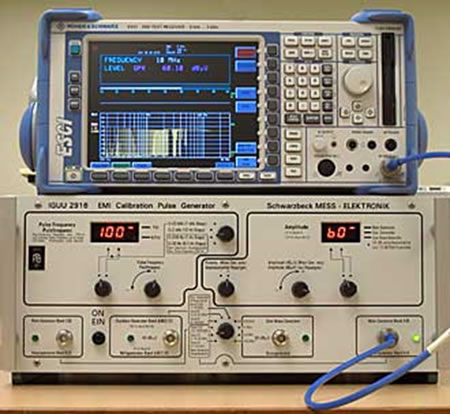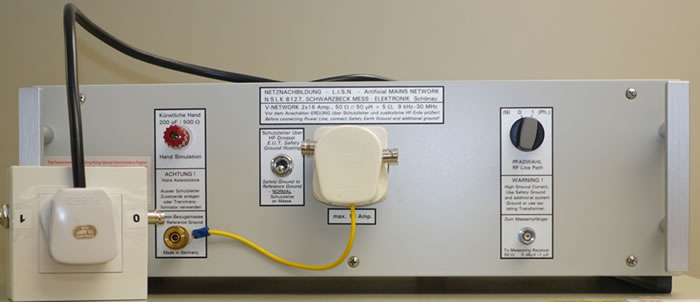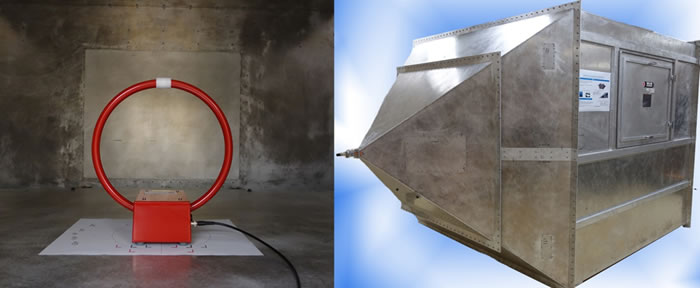Calibration Services
Electrical: EMC Measuring Instruments
EMI Measuring Receiver (EMI Test Receiver)
 Calibration of EMI Measuring Receiver
Calibration of EMI Measuring Receiver
EMI Measuring Receivers (EMI Test Receivers) are used by testing laboratories to perform electromagnetic compatibility (EMC) tests, which are required by the European Community and the USA, for various kinds of electrical and electronic products.
The Standards and Calibration Laboratory can provide calibration services for EMI Measuring Receivers (EMI Test Receivers). The calibration of an EMI Measuring Receiver (EMI Test Receiver) may include the following items:
- Sine-wave voltage measurement accuracy of Peak, Quasi-Peak or Average Detectors (normally conducted at a level of 60 dBµV and at tuning frequencies of 10 kHz, 100 kHz, 1 MHz, 10 MHz, 100 MHz, 500 MHz and 1000 MHz as appropriate).
- Amplitude relationship (absolute calibration) of Quasi-Peak Detectors (normally conducted using reference pulses at 25 Hz or 100 Hz and at tuning frequencies of 100 kHz, 10 MHz, 100 MHz and 500 MHz as appropriate).
- Variation with repetition frequency (relative calibration) of Quasi-Peak Detectors (normally conducted using pulses at 1 Hz, 2 Hz, 5 Hz, 10 Hz, 20 Hz, 25 Hz, 60 Hz, 100 Hz, 1000 Hz or isolated pulse and at tuning frequencies of 100 kHz, 10 MHz, 100 MHz and 500 MHz as appropriate).
- Relative pulse response of Average and Quasi-peak Detectors (normally conducted at pulse repetition rate of 25 Hz, 500 Hz and 5000 Hz and at tuning frequencies of 100 kHz, 10 MHz and 100 MHz as appropriate).
- Variation with pulse repetition frequency of Average Detector (normally conducted at tuning frequencies of 100 kHz, 10 MHz and 100 MHz as appropriate).
- Input impedance (or input VSWR) (measurable frequency range : 0.3 MHz to 18 GHz).
- Accuracy of frequency measurement.
- Time base output frequency.
Artificial Mains Networks (AMN) / Artificial Networks (AN) / Line Impedance Stabilisation Network (LISN)
 Calibration of AMN/LISN
Calibration of AMN/LISN
In electromagnetic compatibility (EMC) testings, an Artificial Mains Networks (AMN) / Line Impedance Stabilisation Network (LISN) is used in conducted emission test. It has the following functions:
- To provide a defined impedance at the power supply terminals of the equipment under test (EUT);
- To isolate the EUT from radio frequency signals from mains supply;
- To couple the disturbance generated by the EUT to EMI measuring receiver.
The Standards and Calibration Laboratory (SCL) provides calibration service for single phase 50 Ω/50 µH + 5 ΩV-network type AMN/LISN in accordance with the International Standard CISPR 16-1-2: 2014 + A1: 2017 over the frequency range 9 kHz to 30 MHz.
A single phase AMN/LISN has two condutors. For each conductor, there are three terminals:
- Terminal to the mains supply (mains port);
- Terminal to the EUT (EUT port);
- Receiver terminal to the EMI measuring receiver (receiver port).
The mains port and the EUT port are AC mains connectors such as Nema, Schuko or BS1363 type AC plug. SCL currently provides calibration services for LISN/AMN with BS1363 type AC plug.
The parameters that can be calibrated are:
- Magnitude and phase of the impedance at the EUT port;
- Voltage division factor between the EUT port and the receiver port;
- Isolation between the mains port and the receiver port.
Loop Antennas
 Calibration of Loop Antenna by TEM cell
Calibration of Loop Antenna by TEM cell
Loop antennas are used for measuring the level of unwanted magnetic fields radiated from electronic devices during electromagnetic compatibility (EMC) testing.
The standard and calibration has set up calibration facilities for calibration of the magnetic antenna factor for loop antenna with frequency range from 1 kHz to 30 MHz.